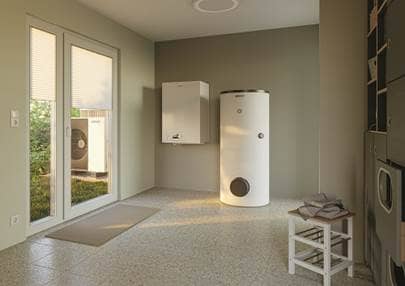
Making the move to monobloc heat pumps
How can we best support installers ready to make the leap from boilers to heat pumps? This question is central to our mission here at BDR Thermea Group. After all, our commitment to accelerate the energy transition is dependent on working closely with installers, which is why our products are always developed with them in mind.
Enter the monobloc air-to-water heat pump. Unlike split heat pumps, monoblocs have only a water connection attached to the device which means the installers don’t have to handle refrigerants, requiring extensive training and certification. By eliminating one of the biggest obstacles to installers working with heat pumps, monoblocs can pave the way for a green energy future. We are focussing on this and we’re offering the monobloc solution in various countries, including through Brötje in Germany.

A hybrid solution for older homes
For many homeowners, switching to a heat pump overnight might not be possible. Older houses, for example, have less effective insulation, meaning their heating demands will be higher. For this reason, our monoblock units are able to work in a hybrid system with traditional boilers. Combining a monobloc and a traditional boiler is a logical combination – installers have experience with traditional boilers and as monoblocs are relatively easy to install, the installers can build up their expertise in hybrid solutions. In this hybrid solution, the heat pump operates for most of the year, with the boiler taking over in the winter months. And not only is a hybrid solution good for older homes, it can also be used in residential properties, with the boiler covering the hot water demand, and the heat pump providing heating to the building.
“This allows for an opportunity to take a big step in decarbonizing existing houses – the comfort of a boiler and the sustainable energy offering of the air-to-water heat pump,” says Alexander Henne, Product Marketing Manager at Brötje. “Diversifying sources of heating, rather than relying only on a boiler, increases reliability and gives end-users peace of mind knowing they are contributing to a green energy future.”
To make this process easier for the installers, our heat pumps use a BDR Control System developed by our Group that allows them to communicate with a boiler. This control system, with a colour display and improved functionalities, allows the hybrid system to automatically choose the right heat generator for each situation, optimizing for cost or CO2 savings. Of course, not every homeowner will have a Brötje boiler, which is why our monobloc systems are able to work with boilers from any manufacturer.
The Brötje monoblocs can have a relatively high output – 18kW – when compared to other heat pumps on the market, making them a viable option as the main heating supply for existing buildings. When doubled and used in a cascade, they could even provide heating for multi-family properties. “Noise output is a key factor in deciding whether to install a heat pump, so our monobloc units are designed with this in mind, and we are constantly working to make them even quieter,” says Sebastien Olszak, Product Manager Heat Pump Business Development Unit.
The future is now – and we’re ready
All new products need some training – no matter how easy to use they are. And our monobloc is no exception. We offer our own training for installers, a qualification and certification programme and on-hand support for the first installation. “Brötje is prepared to help installers make that transition from boilers to heat pumps, which sets us apart from its competitors. Brötje is a partner in this process,” says Alexander.
“Monoblocs will play a vital part in the future of heat pumps: they are a reliable, quiet, and eco-friendly solution, with a high efficiency and ability to adapt to both old and new buildings. For those people eager to play their part in the energy transition, for installers who want to move across from boilers, and for homeowners who may be unable to part with their old boiler just yet, monoblocs are a great solution to help make the transition to greener energy,” concludes Sebastien.


